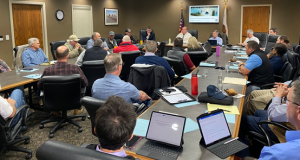The United States Environmental Protection Agency (US EPA) formally invited the Sites Project Authority to apply for a $2.2 billion low-interest loan through the Water Infrastructure Finance and Innovation Act (WIFIA), which would bring the project significantly closer to construction and completion. A loan through the WIFIA program could dramatically reduce the costs to participants, making it more affordable for cities, farms, and resource managers to have access to more water in dry years. Sites Reservoir is significant for California and the nation, and a substantial loan through the WIFIA program will help us realize the many environmental and water supply benefits of this project. Sites Reservoir is a beneficiary pays project, which means that the loan will be repaid by project participants. “The significance of this opportunity cannot be overstated,” said Fritz Durst, chairman of the Sites Project Authority. “We thank our federal partners and the Biden Administration for supporting Sites Reservoir in such a meaningful way.”
Established by the Water Infrastructure Finance and Innovation Act of 2014, the WIFIA program is a federal loan and guarantee program administered by the US EPA. WIFIA’s aim is to accelerate investment in the nation’s water infrastructure by providing long-term, low-cost federal loans for regionally and nationally significant projects. The Sites Project Authority submitted a letter of intent to apply in July 2021. WIFIA funding helps finance drought resiliency projects as well as clean water and safe drinking water infrastructure projects across the United States. After a robust statutorily required review process, the WIFIA Selection Committee selected Sites Reservoir to apply for a loan. “For Sites Reservoir to be built – bringing substantial and critical environmental benefits to California – it has to be affordable for our participants. This loan can get us there,” added Durst. Sites Reservoir is an off-stream water storage facility that will create resiliency against the impacts of climate change. The reservoir does not dam a major river system and would not block fish migration or spawning. Sites Reservoir captures and stores stormwater flows from the Sacramento River —after all other water rights and regulatory requirements are met—for release primarily in dry and critical years for environmental use and for California communities, farms, and businesses when it is so desperately needed.
NEWS & ISSUES
Association Brings In DWR Deputy Directory Overseeing SGMA
The Association hosted a meeting with Department of Water Resources (DWR) Deputy Director, Paul Gosselin, who oversees the Sustainable Groundwater Management Act (SGMA). The meeting included various Ag Associations, County Farm Bureau’s, SJV Water Blueprint members, Growers and other interested stakeholders. Deputy Director Gosselin heard directly from the group about the devastating effects of SGMA not only to agriculture but also to farm workers, disadvantaged communities, the San Joaquin Valley and the entire state of California. Gosselin provided a SGMA update to the group and discussed the different stages of Groundwater sustainability agencies (GSA)’s groundwater sustainability plans (GSP’s). The San Joaquin Valley Water Blueprint discussed its’s efforts related to SGMA. One of the action items coming out of this meeting was the idea to pull together a broader and larger meeting to include legislators.
What does Cotton Acreage Look Like for California in 2022?
With cotton prices where they are today, it comes as no surprise to see an increase in cotton acreage for 2022. Unfortunately, another year of drought will severely limit the amount of acreage that gets planted this year. As of today, California cotton growers are only increasing their plantings this year by approximately 10% despite record cotton prices. Cotton growers planted approximately 120,000 total acres in 2021 and are looking to plant 132,000 acres in 2022.
According to the preliminary planting intentions survey conducted by the California Cotton Ginners and Growers Association this month, the Association is currently estimating approximately only 107,000 acres of pima, 1,600 acres of Hazera and about 24,000 acres of upland statewide for the 2022 cotton season plus or minus 10%. This survey is based on surveys from all of the gins in California and things could change when planting is actually completed and final field surveys are completed by CDFA. If it plays out, it will represent a 26% increase in pima acreage and a 31% decrease in upland acreage in California as compared to 2021. Again, this is preliminary, but reflects what all gins are reporting.
Join Us in Lubbock for the Cotton Grower Cotton Achievement Award Luncheon
2021 Honoree: Ted Sheely

March 30, 2022
Doors open 11:30 a.m. Lunch at noon.
Overton Hotel, Lubbock, Texas
Since 1970, Cotton Grower magazine has annually sought to honor an individual who has demonstrated extraordinary commitment, leadership, and innovation to the cotton industry with the 2021 Cotton Grower Cotton Achievement Award.
The 2021 honoree – Ted Sheely of Lemoore, California – is recognized for his ongoing commitment to industry service on behalf of U.S. cotton, farming innovation, and successful strategic planning.
Please RSVP by March 15
CottonGrower.com/RSVP
Questions? Contact:
Beck Barnes
Business Director, Cotton Grower
662.820.1594 | bbarnes@meistermedia.com
Remarks on current cotton
market outlook by
Dr. John Robinson
Professor and Extension Specialist/Cotton Marketing at Texas A&M University
Free 1 Hour Labor Law Webinars
California Cotton Ginners & Growers Association and Western Agricultural Processors Association are scheduling labor law webinars for members beginning March 10, 2022.
Presented by Fisher & Phillips, the webinars will review employer requirements and answer questions. These 1-hour webinars are free to CCGGA & WAPA members and will take place via Zoom, registration required to receive Zoom logistics prior to the session(s).
Cost:
Members – FREE
Non-members – $25.00
Registration details:
Visit our events page www.wapa-events.com, select Labor Law Webinars or contact our offices (559) 455-9272
Zoom link will be emailed prior to the session(s)
ASABE adds Round Cotton Module Cover Testing to Performance Standard
The American Society of Agricultural and Biological Engineers (ASABE) has completed ASABE S615.2, Cotton Module Cover Material Performance. The document is a major revision of S615.1 that adds performance specifications for module covers used on cylindrical modules, which are now the predominant seed-cotton storage method in the US. Module covers are used to protect the cotton following harvest until it reaches the gin. The ASABE standard provides the physical test requirements for material used to manufacture these covers, which are exposed to environmental conditions, such as wind, rain, and ultraviolet radiation (sunlight) and storage degradation. ASABE is recognized worldwide as a standards developing organization for food, agricultural, and biological systems, with more than 280 standards currently in publication. Conformance to ASABE standards is voluntary, except where required by state, provincial, or other governmental requirements, and the documents are developed by consensus in accordance with procedures approved by the American National Standards Institute. For information on this or any other ASABE standard, contact Scott Cedarquist at 269-932-7031, cedarq@asabe.org.
Association’s Priscilla Rodriguez Completes Prestigious Ag Leadership Program
Revised Indoor Mask Mandate
The Center for Disease Control and Prevention (CDC) issued on February 25, 2022 updated guidance related to face coverings based on the latest data on COVID-19, and on February 28, 2022 California Department of Public Health (CDPH) has issued updated guidance on face coverings to align with the most current CDC guidance. Effective March 1, 2022 CDPH face coverings guidance no longer requires individuals to wear face coverings indoors, except in limited settings where face coverings remain required, and now strongly recommends that all individuals, regardless of vaccination status, continue indoor masking. In addition, Governor Newsom issued an Executive Order with respect to the second readoption of the Cal/OSHA Emergency Temporary Standard (ETS) by extending it an additional 21 days to allow the Occupational Safety and Health Standards Board (OSHSB) additional time to finalize the third readoption of the ETS to align with current public health guidelines and recommendations. This is what we know for now and we will continue to review and monitor the COVID guidance from CDPH as well as the Cal/OSHA ETS.
Federal Maritime Commission Announces Effort to Address Detention and Demurrage Fees
An Advanced Notice of Proposed Rulemaking was recently approved by the Federal Maritime Commission asking if a new rule governing demurrage and detention billing practices would benefit the trade and should apply to marine terminal operators and non-vessel operating common carriers in addition to vessel-operating common carriers. Specifically, the Commission is considering the merits of establishing regulations mandating certain minimum information be included in bills issued for demurrage and detention charges and prescribing the maximum period in which an invoice can be sent. Additionally, the Commission is seeking industry views on whether it should regulate the demurrage and detention billing practices of common carriers and marine terminal operators. The ANPRM broadly defines the terms “demurrage and detention” to include any charges assessed by common carriers and marine terminal operators related to the use of marine terminal space or shipping containers, regardless of the labels given to those charges. The ANPRM is being issued in response to information developed by Commissioner Rebecca F. Dye as part of her work leading Fact Finding 29. In July 2021, she identified issuing an ANPRM on these topics as one of the Interim Recommendations provided to the Commission on how the agency can address complaints and issues related to demurrage and detention. The Commission is requesting comments on what specific information should be required on demurrage and detention bills. It is interested in learning what information is necessary to identify a shipment, and whether bills for demurrage and detention should include information on how the charges are calculated and what circumstances justify stopping the clock on charges. Finally, the Commission is soliciting guidance on how to ensure a bill is being issued to the correct party and whether an explanation of the source and reason for the charge should be required. If you have comments or suggestions, please forward them to the Association.
EPA Approves PM 2.5 Standard Revisions, Finds Valley in Attainment
This week, the U.S. Federal Environmental Protection Agency (EPA) has published the final rule approval for the 1997 24-hour PM2.5 standards as established under the Clean Air Act. With this rule approval designation, U.S. EPA also found that the San Joaquin Valley is in attainment with the 1997 24-hour standard. The standard requires that PM2.5 readings maintain below 65 micrograms/m3 in a 24-hour span. The 1997 standard is one of four major standards under the National Ambient Air Quality Standards (NAAQS) that the Air District must be in attainment with, or be implementing rules to help achieve attainment by specific dates. The Air District originally failed to meet the December 2015 deadline for attainment designation as previously established, and was forced to develop more stringent rules in order to achieve the secondary attainment deadline of December of 2020. Several Air District rules targeting agriculture were developed as a result of this standard, and the standard’s reassessment. With help from the Association, and many other agricultural associations, rules against the industry were limited to only the ones that could achieve the most emissions reductions. This is a significant achievement for the local Air District, and also further highlights the reductions achieved by voluntary and incentive based agricultural programs in the Valley.
